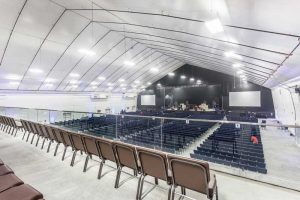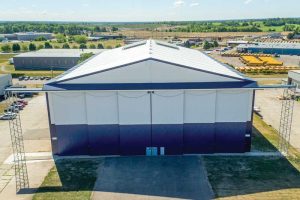
Tension fabric structures have served a key role as a cost-effective facility solution for years. In some cases, users have turned to fabric buildings when brick-and-mortar construction is not economically feasible or would take too long to complete. In other cases, fabric is more suitable to the application in the first place, because its translucency provides natural daylighting or due to the inherent corrosion-resistance of fabric cladding.
The fabric building market remained stable, but also stagnant, for a long time. Most companies in the industry were content to stay in their lane, with advancement efforts mostly focused on providing a slightly modernized version of the same basic niche product that has existed for decades.
In the last decade, technology, new materials, and improved methods have allowed fabric buildings to become a practical option for many construction projects.
These innovations have given the industry a needed push forward, but they have also created new challenges as companies work to learn new processes and properly implement them. At the end of the day, a building is only as good as the people behind it at every step of the design, manufacturing, and installation processes. While enhanced approaches to construction should theoretically expand the life cycles of buildings far beyond that of traditional fabric structures, quality control is paramount to ensure what is being promised is being delivered.
The importance of metal building software
The biggest step forward for fabric structures occurred with the incorporation of rigid-frame engineering, a hallmark of conventional architecture. Traditionally, fabric buildings relied upon hollow-tube, open-web truss frames riddled with subjective designs, leaving ample room for interpretation when evaluating their structural integrity.

The move toward using rigid-frame I-beams and metal building software (MBS) instead of web truss instantly brought more credibility and engineering certainty to fabric buildings. Engineering professionals were now able to look at the plans for fabric structures, universally understand them, and trust the I-beam frame would stand the test of time.
The change allowed for more engineering flexibility and customization. Web truss designs were typically only available in standard, off-the-shelf size configurations, always in a basic hoop shape. Rigid-frame designs, by contrast, begin with a clean sheet and can be fully optimized from the beginning to meet the end user’s exact needs and specifications.
Using finite element analysis (FEA) software, designers can modify the structural framing of a fabric building in numerous ways like conventional brick-and-mortar buildings. Features such as lean-tos, offset peaks, and variable column heights can be incorporated. Thicker steel beams can be applied where needed to account for hanging or collateral loads at specific points on the frames, rather than over-engineering every beam. Rigid-frame buildings can also be designed much larger than web truss structures, making it possible to accommodate higher ceilings or longer clear spans.
Taking control with framing structure
It is one thing to have greater building design capabilities, but it is another for the product to be correctly fabricated as intended. In addition to offering a superior I-beam framing structure, some manufacturers have sought to enhance their quality control measures by bringing their steel beam manufacturing in-house, rather than outsourcing.
Quality control has become a challenge for the fabric structure building type because the materials and components are sometimes shipped from different suppliers directly to the jobsite. It is important to perform a quality evaluation of the materials prior to the start of construction.




